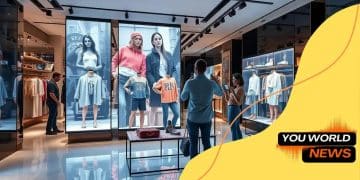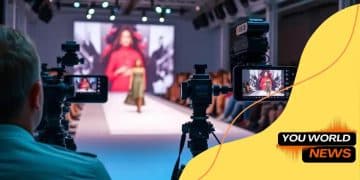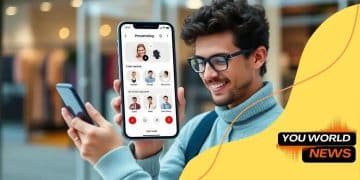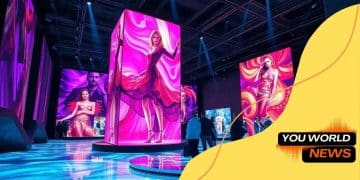The growing importance of virtual try-on technology

The growing importance of virtual try-on technology at events enhances customer engagement, boosts sales, and promotes an interactive shopping experience by allowing attendees to visualize products on themselves using augmented reality.
The growing importance of virtual try-on technology at events is reshaping how attendees engage and interact. Ever wondered how this could elevate user experiences? Come along as we explore this fascinating development.
Understanding virtual try-on technology
Understanding virtual try-on technology is essential for anyone interested in the future of retail and events. This technology allows users to see how products look on them without needing to physically try them on. Imagine standing in front of a screen and wearing clothes or accessories virtually. It’s a game changer!
What is virtual try-on technology?
This innovative approach uses augmented reality (AR) to overlay products onto the user’s live image. Shoppers can experience items in real-time, leading to more informed decisions. It’s like having a fitting room in your pocket!
Benefits of using virtual try-on technology
- Convenience: Consumers can try on products from anywhere, making shopping more accessible.
- Engagement: This tech keeps users entertained and engaged, increasing the time spent on apps and websites.
- Personalization: With advanced algorithms, virtual try-ons can recommend styles that suit individual preferences.
- Reduction in returns: By allowing users to see how items fit them, less likelihood of returns occurs.
These benefits illustrate why businesses are quickly adopting this technology. Companies are not just looking for efficiency; they want to enhance the overall shopping experience.
Furthermore, the integration of virtual try-on technology during events adds an exciting layer for attendees. From beauty brands offering makeup trials to fashion shows where viewers can try outfits, the potential is limitless. This technology builds a connection between brands and attendees, making events memorable.
With the rise of e-commerce, understanding this technology has never been more vital. It bridges the gap between online and offline experiences. As consumers increasingly demand better shopping journeys, virtual try-on solutions become a must-have.
How does it work?
Virtual try-on technology works by using a combination of software and hardware. Users typically utilize an app or website equipped with AR features. Cameras capture images or videos of the consumer, and software analyzes these images in real-time. Then, the products are overlaid onto the user’s image for a realistic view. This seamless process ensures that users have a fun and interactive experience.
As brands continue to experiment with virtual technologies, understanding these concepts is key. The future of shopping lies in enhanced experiences, and virtual try-on technology is leading the charge.
How virtual try-on enhances customer experience
Virtual try-on technology significantly enhances customer experience by offering a unique and engaging shopping process. This innovation allows shoppers to try on products virtually, making the buying journey more interactive and fun.
Key improvements in customer experience
Using virtual try-on technology, customers feel empowered to make informed decisions. They can see how an outfit fits or how a pair of glasses looks on their face before committing to a purchase. This technology reduces uncertainty in online shopping, which is often a major barrier.
- Increased confidence: By visualizing their choices, customers feel more assured about their purchases.
- Reduced returns: Fewer returns occur because users see how items fit before they buy.
- Save time: Shoppers can try on multiple items quickly without the hassle of dressing rooms.
- Fun shopping experience: Interactive elements create excitement and keep customers engaged.
The enhanced customer experience goes beyond ease of use. It also promotes brand loyalty. When customers enjoy their shopping experience, they are more likely to return to that brand. Incorporating virtual try-on technology can create a memorable experience that builds lasting relationships.
Moreover, brands that embrace this technology can differentiate themselves in a crowded market. As competition increases, offering a seamless virtual try-on can be a unique selling proposition. Customers will be drawn to brands that prioritize innovative shopping solutions.
In addition, social media plays a vital role in sharing these experiences. Shoppers love to post about their virtual try-ons, amplifying brand awareness. When consumers engage with virtual try-on features, they often share their experiences online, benefiting brands through organic marketing.
Measuring customer satisfaction
Employing virtual try-on technology is just the beginning. Brands need to monitor customer feedback to understand its impact. Gathering data on how customers interact with the technology can lead to continuous improvements. Surveys and customer reviews will provide insights into what customers love and where improvements are needed.
Virtual try-on technology is not just a trend; it’s the future of retail. Enhancing customer experiences in such an interactive way leads to satisfaction and loyalty, making it an essential tool for modern businesses.
Best practices for implementing technology at events
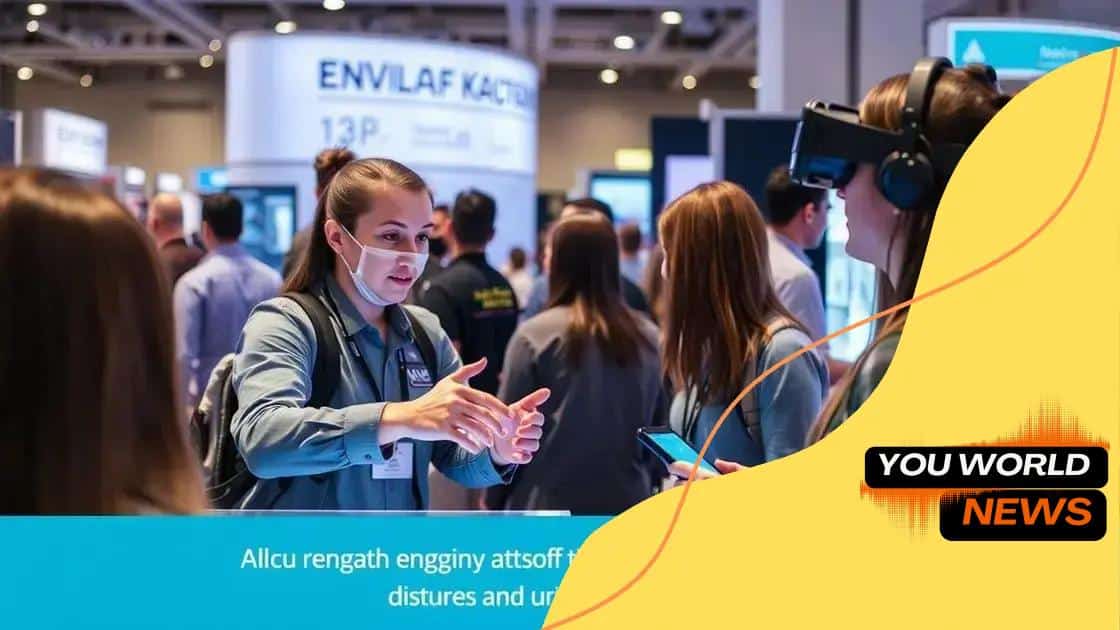
Implementing virtual try-on technology at events can greatly enhance the experience for attendees. To do this successfully, several best practices should be considered. These practices ensure that the technology is effective, engaging, and enjoyable for users.
Selecting the right technology
Choosing the right virtual try-on solution is critical. Different technologies vary in features and capabilities. Consider user-friendliness, compatibility with devices, and the type of products being showcased. Some options include augmented reality apps or mirror displays that project products onto users.
- Ease of use: Ensure that the technology is intuitive for all attendees, regardless of tech-savviness.
- Hardware capabilities: Check that the venue can support the technology, including sufficient internet connectivity and power.
- Product integration: Choose a solution that can easily incorporate the specific products you want to showcase.
Establishing a clear goal for the technology is also vital. What do you aim to achieve? More engagement, capturing leads, or providing entertainment? Defining objectives helps in measuring success later.
Training staff and users
Staff training is essential for a seamless experience. Ensure that event staff is well-informed about how to operate the virtual try-on technology. They should guide attendees on how to use the system effectively, answering any questions that may arise. This support creates a welcoming environment where users feel comfortable.
Encouraging attendees to explore the technology can boost engagement. Consider running workshops or demonstrations that showcase how virtual try-ons work. These sessions can increase participation and excitement.
Another best practice is gathering feedback during and after the event. Attendee feedback can offer valuable insights into their experiences with the technology. Use surveys or direct interactions to capture detailed responses about what worked well and what could improve.
Promoting the technology
Finally, promoting the use of virtual try-on technology before and during the event is crucial. Use social media and email newsletters to inform potential attendees about this exciting feature. Highlight the benefits and how it will enhance their experience at the event. Visual promotions can grab attention, showing previews of how the technology functions. Asking influencers or popular attendees to share their experiences can also increase interest.
By following these best practices, event planners can effectively implement virtual try-on technology, ensuring a successful and memorable experience for all participants.
Case studies of successful events using try-on technology
Exploring case studies of successful events using virtual try-on technology provides valuable insights into its potential. These real-life examples show how brands and organizers can significantly enhance attendee experiences through innovative technology.
Fashion Event Case Study
At a recent fashion show, a leading apparel brand integrated virtual try-on technology to allow attendees to preview outfits on themselves. This interactive experience increased engagement, as guests spent more time at the booth trying different styles. The brand noted a 30% increase in sales during the event, directly attributing this success to the virtual try-on feature.
Beauty Expo Success
Another noteworthy example comes from a beauty expo where various cosmetic brands utilized augmented reality to allow users to try on makeup virtually. Attendees were thrilled to experiment with different looks without applying any products. The interactive experience increased foot traffic to their booths by 50%. Many users shared their experiences on social media, amplifying the brand’s visibility.
- Engagement: The use of virtual try-on led to increased attendee interactions with products.
- Social Sharing: Many participants posted photos online, enhancing brand recognition.
- Increased Sales: Both events showed significant sales boosts attributed to virtual try-ons.
Additionally, a tech-driven trade fair featured several brands showcasing their latest wearables. Attendees could use virtual try-on stations equipped with the latest AR technology. Feedback was overwhelmingly positive, with participants appreciating the ability to see how the products would look on them before purchasing. The event organizers reported higher satisfaction ratings than previous years, demonstrating the effectiveness of these technologies.
These case studies illustrate how integrating virtual try-on technology can transform events. It not only enhances engagement but also boosts sales and brand visibility. As demonstrated, the benefits far exceed the initial investment, making it a wise choice for event planners.
Future trends in virtual try-on technology
The future of virtual try-on technology looks bright, as advancements in augmented reality (AR) and artificial intelligence (AI) continue to evolve. This technology will change how consumers shop and interact with brands. As more retailers adopt virtual try-on solutions, several key trends are emerging.
Increased personalization
One of the most exciting trends is the rise of personalized experiences. As technology becomes more sophisticated, virtual try-ons will analyze user preferences and body types more accurately. This means that shoppers will have a unique experience tailored to their individual needs. By providing personalized recommendations, brands can enhance customer satisfaction and drive sales.
Integration with social media
Another notable trend is the integration of virtual try-on technology with social media platforms. Brands are developing features that allow users to try on products and share their experiences on platforms like Instagram and Snapchat. This not only enhances engagement but also encourages social sharing, as users are more likely to post pictures of themselves using AR features. Social media integration will drive more traffic to e-commerce sites, leading to higher conversions.
- Engagement: Interactive features keep users involved and entertained.
- Brand visibility: Sharing try-on experiences expands brand outreach.
- Increased conversion rates: Users more likely to purchase after sharing or liking a product.
Moreover, the introduction of AR-enabled smart mirrors in physical stores will offer shoppers a deeper experience. Customers can try on clothes or makeup at their convenience without entering a fitting room. This convenience attracts shoppers who prefer a quick and engaging experience over traditional methods.
Enhanced technology capabilities
Advances in AI and machine learning will also enhance virtual try-on technology. These improvements will lead to better visual accuracy in how products are displayed on users. As technology gets smarter, it will provide more realistic color matching, fabric simulation, and texture representation. This creates a better shopping environment where customers can trust what they see.
Additionally, brands will likely introduce features that allow virtual fitting rooms to analyze how different sizes and styles will fit on a person’s body. This could prevent common sizing issues that often lead to returns, enhancing overall customer experience.
In conclusion, the future of virtual try-on technology promises to make shopping more engaging and personalized. As the technology advances, consumers will benefit from improved experiences, making it an exciting area to watch in the retail landscape.
FAQ – Frequently Asked Questions about Virtual Try-On Technology
What is virtual try-on technology?
Virtual try-on technology allows customers to visualize how products, like clothing or accessories, will look on them using augmented reality.
How does virtual try-on improve the shopping experience?
It enhances the shopping experience by providing engaging interactions, personalized recommendations, and reducing uncertainty in purchasing decisions.
Can virtual try-on technology help increase sales?
Yes, by offering customers a fun and interactive way to explore products, brands often see higher conversion rates and reduced return rates.
What are the future trends for virtual try-on technology?
Future trends include more personalization, integration with social media, and enhanced technology capabilities for a more realistic shopping experience.
